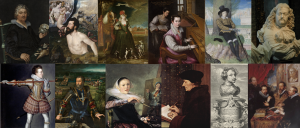 Appel à communication : « ‘Caught in the Act’: the Representation of Action in Early Modern Portraiture » (Renaissance Society of America, Dublin, 2021)
Appel à communication : « ‘Caught in the Act’: the Representation of Action in Early Modern Portraiture » (Renaissance Society of America, Dublin, 2021)
Early modern portraiture, far from being a clearly defined and static genre, is characterized by a progressive departure from strictly descriptive modes of representation. The portrait comes to life through the person’s dress, posture, and facial expression and by the setting and objects that surround them, as well as by its use, agency and performative qualities. As such, the depicted person’s action(s) and ‘acting’ (visual performance) are not limited to physical movement, but might imply a variety of other elements as well.
The increased significance of action is reflected in theoretical writings and humanist inquiries about the notion of self. From the fifteenth century onwards, the parameters that define persona, behavior and appearance underwent continuous scrutiny and were the object of fierce debate. The human self came to be understood as a versatile being, assuming different roles according to the specific context of performance. Looking at action in portraiture – whether drawn, painted, engraved, sculpted or written – allows us to grasp both the apparent as well as underlying structures of the early modern concept of selfhood.
In this panel, we would like to explore the notion of ‘action’ with regard to early modern portraiture in Europe. What does action mean and how does it affect the visual representation, the artistic practice of artists working in this genre, and the portrait’s reception?
Possible subjects include, but are not limited to:
– the representation of a person’s actions
– the role of the background of portraits for action and narrative
– the relation between materiality of the artwork and the suggestion of movement
– hybridity of genres and/or subject-matters (portrait historié, allegorical portrait, tournament or masquerade portraits etc.)
– examples of the agency of portraits
– parallels between visual and literary portraits
– the interaction between word and image (emblematic portraiture and impresa), and how it generates movement and action in portraiture
– engravings, paintings and sculpture of illustrious men, group portraits (guilds, military group etc.) as representing ‘men and women of action’
– the concept of motion and immobility in early modern portraiture
Practical guidelines
Please submit proposals to Angela Benza (angela.benza@unige.ch), Nicolas Bock (Nicolas.Bock@unil.ch) and Marije Osnabrugge (marije.osnabrugge@unige.ch ) by 10 August 2020.
They should include:
– a paper title (max. 15 words)
– an abstract (max. 150 words)
– relevant keywords
– a brief CV (max. one page, including your full name, affiliation, email address, and degree
completion date, past or expected)

Leave a Reply
You must be logged in to post a comment.